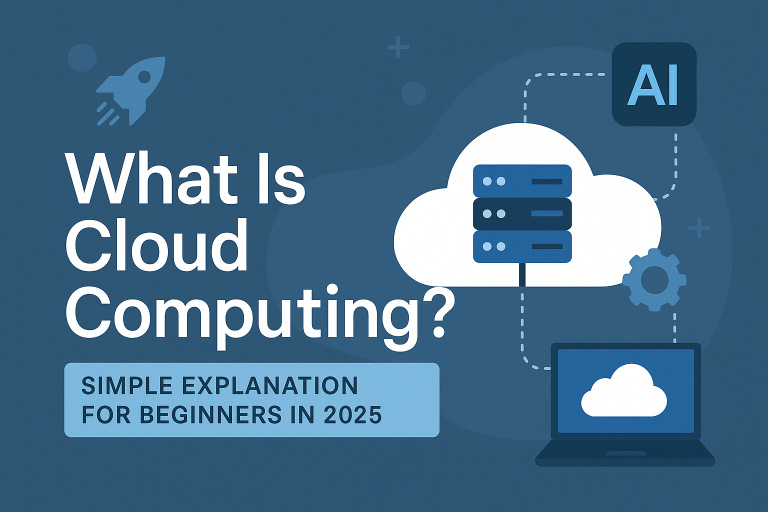The Ultimate Guide to 3 Types of Cloud Computing: Which One Is Right for You?
Types of cloud computing are essential to understand if you’re starting your cloud journey. Whether you’re switching careers or running a business, choosing the right model—public, private, or hybrid—can save you time, money, and stress. In this simple guide, you’ll learn what these types are, how they work, and when to use each one.
What Are the Main Types of Cloud Computing?
The Three Core Models
- Public Cloud: Shared infrastructure offered by providers like AWS, Azure, or Google Cloud. It’s cost-effective and highly scalable.
- Private Cloud: Built exclusively for one organization, offering more control and security.
- Hybrid Cloud: A mix of both, combining flexibility with security.
Related Post: What Is Cloud Computing Elasticity? Fundamentals You Should Know
When Should You Use Each Cloud Model?
Use Case Comparison Table
| Use Case | Best Cloud Type | Why? |
|---|---|---|
| Startup with low cost | Public Cloud | Pay-as-you-go, easy to scale |
| Healthcare company | Private Cloud | Data privacy and compliance |
| Retail with seasonal demand | Hybrid Cloud | Flexibility plus security |
Key Benefits of Cloud Models
Cloud Benefits You Can’t Ignore
- Cost Efficiency (Public)
- Security & Compliance (Private)
- Adaptability (Hybrid)
External source: IBM’s Guide to Cloud Models
How the Cloud Works (Behind the Scenes)
A Peek Into the Tech
At a high level, cloud computing works by hosting data and services in remote data centers. Your laptop becomes a “dumb terminal,” and the heavy lifting is done remotely.
Public cloud providers offer infrastructure (IaaS), platforms (PaaS), and software (SaaS) services, giving you options from raw compute power to full-featured apps.
Choosing the Right Cloud Model for You
Practical Tips for Beginners
- Budget-conscious or solo entrepreneur? → Public Cloud
- Handling private customer data? → Private Cloud
- Need best of both worlds? → Hybrid Cloud
Common Misconceptions About Cloud Computing Types
Don’t Let These Myths Hold You Back
There are a few common myths about the types of cloud computing that often confuse beginners. Let’s clear them up so you can move forward with confidence.
- Myth #1: Public cloud is less secure. While public cloud infrastructure is shared, top providers like AWS and Google Cloud offer enterprise-grade security. The real risk comes from misconfigurations—not the model itself.
- Myth #2: Private cloud is always better. Not necessarily. Private cloud offers more control, but it’s expensive and requires skilled IT teams to manage. For many businesses, hybrid or public models make more sense.
- Myth #3: Hybrid cloud is only for large enterprises. Even small businesses can benefit from hybrid setups—especially when they want flexibility without sacrificing data control.
Conclusion
The types of cloud computing—public, private, and hybrid—each serve different needs. By understanding their strengths, you can confidently choose the one that fits your career or business.
Next step: Subscribe to get our free cloud career roadmap.
FAQ
What are the types of cloud computing?
The three main types are public, private, and hybrid clouds. Each serves different needs based on control, cost, and scalability
How do beginners get started with types of cloud computing?
Start with the public cloud using free-tier services like Google Cloud or AWS. Then explore hybrid or private models as your needs grow.
Are types of cloud computing hard to understand?
Not really! Think of it as different ways to rent or own computing resources—like Netflix (public), owning DVDs (private), or combining both (hybrid).
What tools support types of cloud computing?
AWS, Google Cloud, and Azure support all types. Tools like Terraform and Kubernetes can help manage hybrid and private setups.
Types of cloud computing vs cloud benefits?
Cloud types refer to models (public/private/hybrid), while cloud benefits describe their advantages like cost savings, speed, and flexibility.
🚀 Want a Clear Plan to Start Your Cloud + AI Career?
Download the free Cloud Career Blueprint — a step-by-step guide to help you learn the right skills, avoid overwhelm, and start building a high-value career in tech.
👉 Just enter your email below and I’ll send it straight to your inbox.







